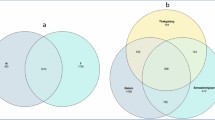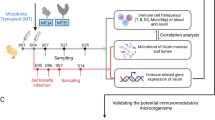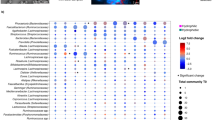Abstract
The transition from a sterile gut environment to the development of microbiota in the newborns is not fully understood. The objective of this study was to investigate the impact of exposure to bacterial communities on the development of gut microbiota in the newly hatched chicken. A total of 90 as-hatched chicks were divided into three groups. Groups A and B were treated with inocula of the cecal origin, whereas group C was fed with sterile water. The major bacteria in Inoculum-I to treat group A included Bacteroides (20.7%), Lachnospiraceae (17.2%) and unclassified Ruminococcaceae (16.1%), whereas group B was introduced with Inoculum-II composed of Prevotella (37.9%), Acidaminococcus (16.1%) and Dorea (12.6%). Analyses of the ileal and cecal contents over a period of 15 days showed that Inoculum-I resulted in a higher rate of colonization than Inoculum-II, but the colonization was predominantly in the cecum. The influence of Inoculum-II on group B was similar to that of water on group C, showing only a marginal effect on colonization. Microarray analysis showed that each group presented a distinct pattern of gene expression in the ileum. In group A, the most obvious changes were noted in genes controlling the function of ion transport, cell cycle and chromosome maintenance, suggesting that the inocula influenced gene expression. Our findings indicate that initial exposure to different bacterial communities could lead to the development of distinct microbiota and gene expression in the gut. It is possible to manipulate the gut microbiota by feeding to a proper bacterial composition at an early age.
Similar content being viewed by others
Log in or create a free account to read this content
Gain free access to this article, as well as selected content from this journal and more on nature.com
or
Accession codes
References
Barrow P . (1992). Probiotics for chickens. In: Fuller R (ed). Probiotics, The Scientific Basis. Chapman and Hall: London, pp 225–257.
Binder HJ, Mehta P . (1989). Short-chain fatty acids stimulate active sodium and chloride absorption in vitro in the rat distal colon. Gastroenterology 96: 989–996.
Callaway TR, Dowd SE, Wolcott RD, Sun Y, McReynolds JL, Edrington TS et al. (2009). Evaluation of the bacterial diversity in cecal contents of laying hens fed various molting diets by using bacterial tag-encoded FLX amplicon pyrosequencing. Poult Sci 88: 298–302.
Csordas A . (1995). Toxicology of butyrate and short-chain fatty acids. In: Hill MJ (ed). Role of Gut Bacteria in Human Toxicology and Pharmacology. Taylor and Francis: London, pp 105–125.
Cummings JH . (1984). Colonic absorption: the importance of short chain fatty acids in man. Scan J Gastroenterol Suppl 93: 89–99.
Ferreira AJP, Ferreira CSA, Knobl T, Moreno AM, Bacarro MR, Chen M et al. (2003). Comparison of three commercial competitive-exclusion products for controlling Salmonella colonization of broilers in Brazil. J Food Protect 66: 490–492.
Genovese KJ, Anderson RC, Harvey RB, Callaway TR, Poole TL, Edrington TS et al. (2003). Competitive exclusion of salmonella from the gut of neonatal and weaned pigs. J Food Protect 66: 1353–1359.
Gibson GR, Wang X . (1994). Enrichment of bifidobacteria from human gut contents by oligofructose using continuous culture. FEMS Microbiol Lett 118: 121–127.
Gong J, Yu H, Liu T, Gill JJ, Chambers JR, Wheatcroft R et al. (2008). Effects of zinc bacitracin, bird age and access to range on bacterial microbiota in the ileum and caeca of broiler chickens. J Appl Microbiol 104: 1372–1382.
Good IJ . (1953). The population frequencies of species and the estimation of population parameters. Biometrika 40: 237–264.
Holben WE, Feris KP, Kettunen A, Apajalahti JH . (2004). GC fractionation enhances microbial community diversity assessment and detection of minority population of bacteria by denaturing gradient gel electrophoresis. Appl Environ Microbiol 70: 2263–2270.
Hume ME, Kubena LF, Edrington TS, Donskey CJ, Moore RW, Ricke SC et al. (2003). Poultry digestive microflora biodiversity as indicated by denaturing gradient gel electrophoresis. Poult Sci 82: 1100–1107.
Knarreborg A, Simon MA, Engberg RM, Jensen BB, Tannock GW . (2002). Effects of dietary fat source and subtherapeutic levels of antibiotic on the bacterial community in the ileum of broiler chickens at various ages. Appl Environ Microbiol 68: 5918–5924.
Lane DJ . (1991). 16S/23S rRNA sequencing. In: Stackebrandt E, Goodfellow M (eds). Nucleic Acid Techniques in Bacterial Systematics. John Wiley and Sons: New York, pp 115–175.
Leser TD, Lindecrona RH, Jensen TK, Jensen BB, Møller K . (2000). Changes in bacterial community structure in the colon of pigs fed different experimental diets and after infection with brachyspira hyodysenteriae. Appl Environ Microbiol 66: 3290–3296.
Li CJ, Elsasser TH . (2005). Butyrate-induced apoptosis and cell cycle arrest in bovine kidney epithelial cells: involvement of caspase and proteasome pathways. J Anim Sci 83: 89–97.
Li RW, Li C . (2006). Butyrate induces profound changes in gene expression related to multiple signal pathways in bovine kidney epithelial cells. BMC Genomics 7: 234–248.
Lillehoj HS, Trout JM . (1996). Avian gut-associated lymphoid tissues and intestinal immune responses to Eimeria parasites. Clin Microbiol Rev 9: 349–360.
Livak KJ, Schmittgen TD . (2001). Analysis of relative gene expression data using real-time quantitative PCR and the 2(-Delta Delta C(T)) method. Methods 25: 402–408.
Lu J, Idris U, Harmon B, Hofacre C, Maurer JJ, Lee MD . (2003). Diversity and succession of the intestinal bacterial community of the maturing broiler chicken. Appl Environ Microbiol 69: 6816–6824.
Mazmanian SK, Liu CH, Tzianabos AO, Kasper DL . (2005). An immunomodulatory molecule of symbiotic bacteria directs maturation of the host immune system. Cell 122: 107–118.
Mead GC . (2000). Prospects for competitive exclusion treatment to control salmonellas and other food borne pathogens in poultry. Vet J 159: 111–123.
Metchnikoff E . (1903) In: Prolongation of Life. G Putnam's Sons: New York.
Moran Jr ET . (1982) In: Comparative Nutrition of Fowl and Swine, The Gastrointestinal Systems. University of Guelph: Guelph, ON, Canada.
Muyzer G . (1999). DGGE/TGGE a method for identifying genes from natural ecosystems. Curr Opin Microbiol 2: 317–322.
Rawls JF, Mahowald MA, Ley RE, Gordon JI . (2006). Reciprocal gut microbiota transplants from zebrafish and mice to germ-free recipients reveal host habitat selection. Cell 127: 423–433.
Revolledo L, Ferreira CSA, Ferreira AJP . (2003). Comparison of experimental competitive-exclusion cultures for controlling Salmonella colonization in broiler chicks. Braz J Microb 34: 354–358.
Pivnick H, Nurmi E . (1982). The Nurni concept and its role in control of salmonella in poultry. In: Davies R (ed). Developments in Food Microbiology—I. Applied Science Publishers Ltd: Barking, Essex England, pp 41–70.
Schloss PD, Handelsman J . (2005). Introducing DOTUR, a computer program for defining operational taxonomic units and estimating species richness. Appl Environ Microbiol 71: 1501–1506.
Schneitz C . (2005). Competitive exclusion in poultry—30 years of research. Food Control 16: 657–667.
Singleton DR, Furlong MA, Rathbun SL, Whitman WB . (2001). Quantitative comparisons of 16S rRNA gene sequence libraries from environmental samples. Appl Environ Microbiol 67: 4374–4376.
Shima T, Fukushima K, Setoyama H, Imaoka A, Matsumoto S, Hara T et al. (2008). Differential effects of two probiotic strains with different bacteriological properties on intestinal gene expression, with special reference to indigenous bacteria. FEMS Immunol Med Microbiol 52: 69–77.
Stavric S, D'Aoust JY . (1993). Undefined and defined bacterial preparation for the competitive exclusion of Salmonella in poultry—a review. J Food Protect 56: 173–180.
Suzuki S, Shimojo N, Tajiri Y, Kumemura M, Kohno Y . (2007). Differences in the composition of intestinal Bifidobacterium species and the development of allergic diseases in infants in rural Japan. Clin Exp Allergy 37: 506–511.
Thompson CL, Wang B, Holmes AJ . (2008). The immediate environment during postnatal development has long-term impact on gut community structure in pigs. ISME J 2: 739–748.
Turnbaugh PJ, Hamady M, Yatsunenko T, Cantarel BL, Duncan A, Ley RE et al. (2009). A core gut microbiome in obese and lean twins. Nature 457: 480–484.
Van der Wielen PW, Keuzenkamp DA, Lipman LJ, van Knapen F, Biesterveld S . (2002). Spatial and temporal variation of the intestinal bacterial community in commercially raised broiler chickens during growth. Microb Ecol 44: 286–293.
Wang ML, Suo X, Gu JH, Zhang WW, Fang Q, Wang X . (2008). Influence of grape seed proanthocyanidin extract in broiler chickens: effect on chicken coccidiosis and antioxidant status. Poult Sci 87: 2273–2280.
Wise MG, Siragusa GR . (2007). Quantitative analysis of the intestinal bacterial community in one- to three-week-old commercially reared broiler chickens fed conventional or antibiotic-free vegetable-based diets. J Appl Microbiol 102: 1138–1149.
Yang J, Zou Y, Zhu J . (2009). Identifying differentially expressed genes in human acute leukemia and mouse brain microarray data sets utilizing QTModel. Funct Integr Genomics 9: 59–66.
Zhu XY, Zhong T, Pandya Y, Joerger RD . (2002). 16S rRNA-based analysis of microbiota from the cecum of broiler chickens. Appl Environ Microbiol 68: 124–137.
Acknowledgements
This research was supported by the Science and Technology Department of Zhejiang Province through the Agricultural Privilege Project (2006C22053) as well as the Zhejiang Academy of Agricultural Science through the Cooperation Project. The collection of chickens from commercial chicken farms was made possible by the support of Mr Weiwu Zhang, the Hangzhou Academy of Agricultural Sciences. QT model analysis for microarray data was performed by Dr LongJiang Fan and Ms Chengyin Ye from Zhejiang University. We also thank Qun Fang, TingWu Yang, Weilan Wang and Xi Yang for technique and bio-information support. Finally, we thank Dr Hongwei Yu and Mr Ryan Withers from Marshall University for editing this paper.-
Author information
Authors and Affiliations
Corresponding authors
Additional information
Supplementary Information accompanies the paper on The ISME Journal website (http://www.nature.com/ismej)
Supplementary information
Rights and permissions
About this article
Cite this article
Yin, Y., Lei, F., Zhu, L. et al. Exposure of different bacterial inocula to newborn chicken affects gut microbiota development and ileum gene expression. ISME J 4, 367–376 (2010). https://doi.org/10.1038/ismej.2009.128
Received:
Revised:
Accepted:
Published:
Issue date:
DOI: https://doi.org/10.1038/ismej.2009.128
Keywords
This article is cited by
-
Systematic profiling of the chicken gut microbiome reveals dietary supplementation with antibiotics alters expression of multiple microbial pathways with minimal impact on community structure
Microbiome (2022)
-
Influence of lincomycin-spectinomycin treatment on the outcome of Enterococcus cecorum infection and on the cecal microbiota in broilers
Gut Pathogens (2022)
-
Delayed access to feed early post-hatch affects the development and maturation of gastrointestinal tract microbiota in broiler chickens
BMC Microbiology (2022)
-
Poultry gut health – microbiome functions, environmental impacts, microbiome engineering and advancements in characterization technologies
Journal of Animal Science and Biotechnology (2021)
-
Age-related changes of microbiota in midlife associated with reduced saccharolytic potential: an in vitro study
BMC Microbiology (2021)



